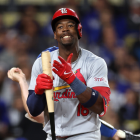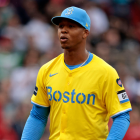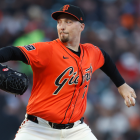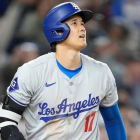There are 10 days remaining in the 2019 regular season. Those 10 days will decide the various postseason and awards races, then it'll be on to the postseason to crown a World Series champion. After that, MLB will jump right into the offseason and what could be another slow-moving market for free agents.
Here are our 2019-20 MLB Free Agent Power Rankings for September. In this week's Free Agent Stock Watch we're going to break down a high-profile closer who could -- could -- jump into the mix this winter, as well as two veteran players unlikely to have their 2020 club options exercised.
Stock Up
The Yankees have the best and deepest bullpen in baseball, and anchoring that bullpen is closer Aroldis Chapman. Chapman is having another dynamite season this year, saving 37 games in 42 chances and holding opponents to a .189/.280/.270 batting line. It has been another typically dominant season for the Cuban Missile.
Chapman turns 32 in February and Father Time has a way of reducing velocity. Once a historically hard-thrower who averaged -- averaged -- 101.1 mph with his fastball just four years ago, Chapman is averaging 98.3 mph with his heater this year. That's still really good, obviously, but the days of pumping 102-103 mph (or higher!) every pitch are over.
To compensate, Chapman has increased his slider usage in recent years, so much so that there are days he appears more comfortable throwing the slider when he needs a strike to get back in the count.

The Yankees gave Chapman a five-year contract worth $86 million three years ago and he can opt out following this season. The contract is slightly front-loaded, so, if he does opt out, Chapman would leave two years and $30 million on the table.
On one hand, Chapman is a soon-to-be 32-year-old reliever with a bit of an injury history (shoulder trouble in 2017, knee trouble in 2018) who is losing velocity. On the other hand, Chapman is still excellent, and he's shown the aptitude to make adjustments and remain effective despite the diminishing fastball (by throwing more sliders). There are pluses and minuses.
A few weeks ago it was reported Chapman will "one million percent" opt out after the season, but it was a bit of a flimsy report -- it cited the prediction of a "player who is friendly with Chapman" -- and Chapman immediately shot it down.
Aroldis Chapman calls the report he wants to opt out of his Yankees contract after this year “completely false.” Adds: “the truth is, honestly, I feel great here.”
— Coley Harvey (@ColeyHarvey) July 17, 2019
If Chapman does opt out, the Yankees will undoubtedly make him the qualifying offer -- Chapman won't opt out of $30 million only to accept the $19 million or so qualifying offer -- which will entitle them to draft pick compensation should he sign elsewhere. That could affect Chapman's market, as we've seen with other prominent free agents in recent offseasons.
Fortunately, we have a recent benchmark for free agent contracts: Craig Kimbrel. Kimbrel became a free agent at age 30 last year and there were all sorts of stories about his red flags, yet his overall numbers last year were on par with Chapman's this year.
| IP | ERA | WHIP | K/9 | BB/9 | HR/9 | Opp. AVG/OBP/SLG | |
|---|---|---|---|---|---|---|---|
2018 Kimbrel | 62 1/3 | 2.74 | 0.96 | 13.9 | 4.5 | 1.0 | .146/.260/.305 |
2019 Chapman | 54 1/3 | 2.32 | 1.14 | 13.3 | 4.1 | 0.5 | .189/.280/.270 |
Kimbrel did not sign until June, after the draft pick compensation went away, and he signed what amounts to a 2 1/2-year contract worth $43 million. Walking away from two years and $30 million and getting a Kimbrel contract would be a win for Chapman, even if he has to wait until June to get it. This winter might be Chapman's last chance at a big payday.
Chapman and his representatives at ISE Baseball could also try to leverage the opt-out clause into an extension. CC Sabathia did that back in 2011. He leveraged his opt-out into an extra year and $30 million. Perhaps the Yankees could convince Chapman to stay by tacking one year and, say, $15 million onto his current deal, turning it into a three-year pact worth $45 million.
The Yankees clearly value having a deep and powerful bullpen and they've invested heavily in that bullpen in recent years. They could lose Dellin Betances to free agency -- his availability early next year is in question following his recent Achilles injury -- and then losing Chapman on top of that would leave them short a few arms. Chapman definitely has leverage.
At the same time, the Yankees could call his bluff and let him test the market as a qualified free agent. Going to opt out? That's fine, we'll sign Will Smith instead and get a really great reliever anyway, and probably save money in the process. The Yankees have done that before. They let David Robertson leave in 2014 and replaced him with Andrew Miller, who had yet to really break out.
Coming into the season I thought there was little chance Chapman would opt out given the market and Kimbrel's ongoing free agency. Now, after Kimbrel landed $43 million and Chapman had another excellent season (and stayed healthy), the odds he uses the opt-out clause are increasing. My guess right now is he uses the opt out, but I don't feel confident in that at all.
Stock Down
This was a make or break year for Mets center fielder Juan Lagares. Injuries limited the 30-year-old to 203 games from 2016-18, and this year he came to spring training as the only true center fielder on the team's roster. Others like Brandon Nimmo and Michael Conforto are best suited for a corner.
Rather than capitalize on his opportunity as a platoon center fielder -- and the extra playing time created by Nimmo's lengthy stint on the injured list -- Lagares has had the worst offensive season of his career, and he's hitting only .230/.269/.365 against lefties. Hitting southpaws is supposed to be his bread and butter at the plate.
Also, Lagares has seen his defensive value plummet. The eye test suggests it and the numbers confirm it. Here is his Ultimate Zone Rating per 150 games over the last few years:
- 2017: +22.8
- 2018: +17.2
- 2019: -7.7
The Mets hold a $9.5 million club option for Lagares for next season and there is little chance they pick it up. They'll pay him the $500,000 buyout and spend the remaining $9 million elsewhere. Lagares is young enough and has a good enough defensive reputation that he'll hook on somewhere this winter. A minor-league contract or low-base salary one-year deal is the likely outcome.
Journeyman southpaw Wade LeBlanc was a great story for the Mariners last year. The 35-year-old made 27 starts (and five relief appearances) and threw 162 innings with a 3.72 ERA. Not great, but certainly a rock solid performance.
The Mariners rewarded LeBlanc with a one-year contract extension last July that included three club option years and a plenty of performance bonuses. Here's the breakdown:
- 2019: $2.75 million
- 2020: $5.5 million club option ($450,000 buyout)
- 2021: $5 million club option ($450,000 buyout)
- 2022: $5 million club option ($450,000 buyout)
Innings escalators bumped the 2020 base salary up from $5 million to $5.5 million, and LeBlanc could still add another $150,000 to that total before the end of the season. It's a low risk contract for Seattle and a little peace of mind for a guy who's bounced around his entire career.
Unfortunately, LeBlanc was unable to repeat last year's success this year. He was demoted to the bullpen weeks ago and is a lower leverage long man who soaks up innings for a losing team. There is no such thing as too much pitching depth, so bringing LeBlanc back at $5.5 million wouldn't be the end of the world, but it seems unlikely. The Mariners can fill that role cheaply.




























